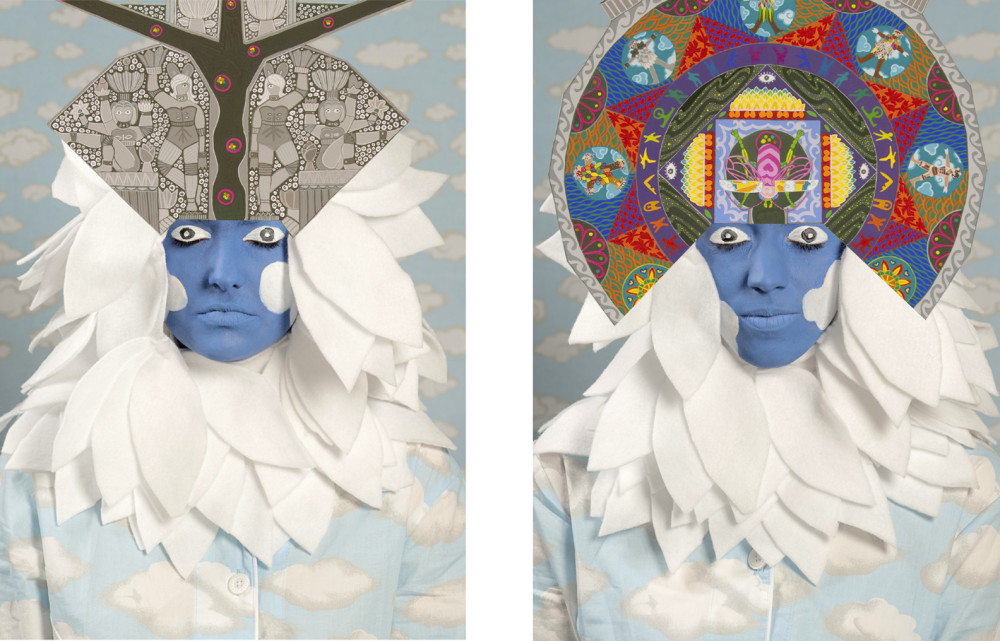Portrait by Elia Alba, 2014. Behind the scenes photograph of Saya Woolfalk for Alba’s upcoming book The Supper Club. All images ©Saya Woolfalk, courtesy Leslie Tonkonow Artworks+Projects, New York.
MUSÉE: Do you still refer to your creations as ‘No Placeans’? Are they people? Aliens? In your mind, what makes a person?
SAYA WOOLFALK: The first part of my project was called No Place (2006-2008), and the plant-hu- mans hybrids who populate that work are called the No Placeans. In 2009, I started working on The Empathics, a group of fictional human women who try to become like the people of No Place through science and ritual. The Empathics are ordinary people who physically metamorphose as they merge cultural identities and cross species.
M: Can you describe your utopia that your characters inhabit – No Place?
SW: No Place is a future race of plant-humans, who change gender and color, use our refuse as usable technologies, and turn back into the landscape when they die. They eat, sleep, live in complex family structures, and die.
M: It’s interesting that NoPlacian sounds like Neoplatonist, who attempted to reconcile the classical and the christian philosophy sort of in the same way you reconcile the various disparate cultures in your work. Was this an intentional pun?
SW: Actually the title is derived from the English word, “utopia,” coined by Sir Thomas More from the Greek “no” (ou) and “place” (topos)--literally, no place. In the tradition of the folk tale, No Place is the repository of the dreams of many: dancers, artists, curators, students, teachers, biologists, and anthropologists all participated in producing the contours of this place.
M: What do you consider the final product in your work? The performance? The sculpture? The documentation?
SW: All of the work combined is what I think of as the final product. Every time someone encounters one of my pieces I hope it stimulates them to seek out another; like chapters in a book or fragments from a new culture.
M: Can we talk about all the mediums you work in? Do you go through phases of, say, sculpture vs performance?
SW: When I am in the studio, I have sculptures, videos, paintings, collages, and costumes all in produc- tion simultaneously. I am currently working on collages, a video, and new sculptures for my show at Leslie Tonkonow Gallery in January, and a meditation event as a part of my exhibition currently up at Smack Mellon Gallery in Brooklyn.
M: You worked with DJ Spooky at the Asian Art Museum (which was awesome)– do you often get a chance to combine your work with contemporary producers.
SW: Thank you! Working on the piece at the Asian Art Museum was really a wonderful experience. DJ Spooky (Paul Miller) has been incredibly generous in lending me his music for a few projects. The next piece we will be presenting is a performance at the Chrysler Museum in Virginia in November during my solo show ChimaTEK: Life Products.
To make almost all of my work, I incorporate the brilliant creativity and skill of many dancers, film- makers, musicians, and animators. I love working collaboratively with people.
M: I see a lot of early Mesoamerican influence in your work – mostly because of the feathers and the idea of the god Quetzalcoatl is this a large influence?
SW: I try to have a large breath of visual references in my work, and I do love the imagery associated with Quetzalcoatl. We took a family trip to Teotihuacan last summer and my work was pretty imme- diately inspired by that trip.
M: What part does spirituality, if any, play in your work? SW: I often use the language of sacred spaces like shrines and temples to create a sentiment of wonderment and awe in my installations.
M: Do you view the metamorphosis of your (No Placeans?) as a parable / fable about our world?
SW: Living and working in New York, I encounter people from all around the world on a daily basis. There’s an energy when people come in and out of contact with one another, and it causes our cultures to transform, which is something I try to capture in the stories I tell with my work.
M: What is your ultimate fable, where do you want to take the viewer?
SW: The answer to this is always changing based on the project I am working on. Currently I’m finishing up work on my project ChimaTEK, in which the initial nonprofit drives of the Empathics’ Insititue of Empathy are transformed into salable technologies. I try to incorporate the push and pull of utopian and dystopian impulses in my work, to create a tension in what can be consumed as pleasurable visual art.
M: What is your ritual?
SW: My days are pretty ritualized. I wake up in the morning and get my daughter Aya ready for school, then go to the studio all day. At the end of the day, I pick Aya up, we walk home and have dinner with my husband Sean. In the evening, we like to spend time together as a family. I start that ritual again when I wake up the next day.
 (Left image) An Empathic Preparing to Paint Images from the Book Empathetic Plant Alchemy (Anna), 2011 ; (Right image) An Empathic Preparing to Paint Images from the Book Empathetic Plant Alchemy (Jillian), 2011. ©Saya Woolfalk, courtesy of Leslie Tonkonow Artworks+Projects, New York.
(Left image) An Empathic Preparing to Paint Images from the Book Empathetic Plant Alchemy (Anna), 2011 ; (Right image) An Empathic Preparing to Paint Images from the Book Empathetic Plant Alchemy (Jillian), 2011. ©Saya Woolfalk, courtesy of Leslie Tonkonow Artworks+Projects, New York.



